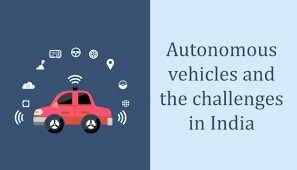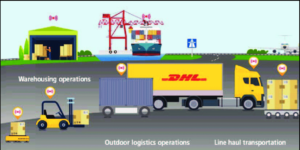Introduction
The transportation and logistics industry has seen a significant shift in recent years with the adoption of autonomous vehicles. The use of these self-driving vehicles is set to revolutionize the way goods are transported, and logistics operations are carried out. This article explores the future of vehicles in logistics and transportation, the advancements made, and the challenges faced.

Advancements in Autonomous
Vehicles Autonomous vehicles have come a long way in recent years, with significant advancements made in areas such as sensors, mapping technology, and machine learning algorithms. These advancements have made it possible for vehicles to navigate complex environments, make decisions, and interact with other vehicles and objects on the road. In logistics and transportation, these advancements have led to increased efficiency and improved safety in the transportation of goods.
Impact on Logistics Operations
The adoption of autonomous vehicles is set to transform the logistics industry, with the potential to reduce costs, increase efficiency, and improve delivery times. Autonomous vehicles can operate 24/7, without the need for rest or breaks, meaning that goods can be transported faster and more efficiently than ever before. They can also be used to transport goods over long distances, reducing the need for human drivers and increasing the safety of the journey.

Challenges Facing Autonomous Vehicles
Despite the many advantages of autonomous vehicles, there are also several challenges that need to be addressed. One of the biggest challenges is the development of reliable and safe technology. Autonomous vehicles must be able to operate safely in a range of different environments, and the technology must be able to adapt to changing conditions. There is also the issue of cybersecurity, with the potential for hackers to gain access to the technology and cause accidents or disruption.
Another challenge facing the adoption of autonomous vehicles in logistics and transportation is the regulatory environment. Governments and regulatory bodies must create a legal framework that supports the safe and efficient use of vehicles. There must also be guidelines in place for the operation of autonomous vehicles on public roads, including how they interact with other vehicles and pedestrians.
The future of autonomous vehicles in logistics and transportation is bright, with the potential to revolutionize the industry. The advancements made in technology have led to increased efficiency and improved safety, with the potential for cost savings and faster delivery times. However, there are also challenges that need to be addressed, including the development of safe and reliable technology and the creation of a supportive regulatory environment.

Applications of Autonomous Vehicles in Logistics and Transportation
Autonomous vehicles have several applications in logistics and transportation. One of the most significant applications is in the transportation of goods. Autonomous vehicles can be used to transport goods from one location to another without the need for human intervention. This can significantly reduce the cost of transportation and increase the speed of delivery. Autonomous vehicles can also be used to transport goods over long distances, reducing the need for human drivers and increasing the safety of the journey.
Another application of autonomous vehicles is in last-mile delivery. Last-mile delivery refers to the delivery of goods from a transportation hub to the final destination, which is often a residential address. Autonomous vehicles can be used for last-mile delivery, which can significantly reduce the cost of transportation and increase the speed of delivery.
Challenges Facing the Adoption of Autonomous Vehicles in Logistics and Transportation
The adoption of autonomous vehicles in logistics and transportation is not without its challenges. One of the biggest challenges is the development of reliable and safe technology. Autonomous vehicles must be able to operate safely in a range of different environments, and the technology must be able to adapt to changing conditions. There is also the issue of cybersecurity, with the potential for hackers to gain access to the technology and cause accidents or disruption.
Another challenge facing the adoption of vehicles in logistics and transportation is the regulatory environment. Governments and regulatory bodies must create a legal framework that supports the safe and efficient use of autonomous vehicles. There must also be guidelines in place for the operation of autonomous vehicles on public roads, including how they interact with other vehicles and pedestrians.
The lack of public acceptance is also a significant challenge. There is still a lack of trust in the safety of vehicles, and many people are uncomfortable with the idea of a vehicle operating without human intervention. This lack of public acceptance could slow down the adoption of autonomous vehicles in logistics and transportation.
Future Developments in Autonomous Vehicles in Logistics and Transportation
As technology continues to advance, the future of vehicles in logistics and transportation looks bright. Several developments are on the horizon that could significantly improve the efficiency and safety of vehicles.
One area of development is in the use of artificial intelligence (AI) and machine learning (ML) algorithms. These technologies can be used to improve the decision-making capabilities of autonomous vehicles, enabling them to make more informed decisions and adapt to changing conditions. This could significantly improve the safety and efficiency of vehicles in logistics and transportation.

Another area of development is in the use of 5G technology. 5G technology can significantly improve the speed and reliability of communication between autonomous vehicles and other vehicles on the road. This could enable faster and more efficient communication between vehicles, leading to safer and more efficient transportation of goods.
The development of smart infrastructure is also an area of development that could significantly improve the efficiency and safety of autonomous vehicles. Smart infrastructure refers to the use of sensors and other technologies to collect data and provide real-time information about road and weather conditions. This information can be used by vehicles to make more informed decisions and adapt to changing conditions, leading to safer and more efficient transportation of goods.

Conclusion
The future of vehicles in logistics and transportation is bright, with the potential to revolutionize the industry. The advancements made in technology have led to increased efficiency and improved safety, with the potential for cost savings and faster delivery times. However, there are also challenges that need to be addressed, including the development of safe and reliable technology and the creation of a supportive regulatory environment. By addressing these challenges and embracing future developments, the full potential of autonomous vehicles in logistics and transportation can be realized.


